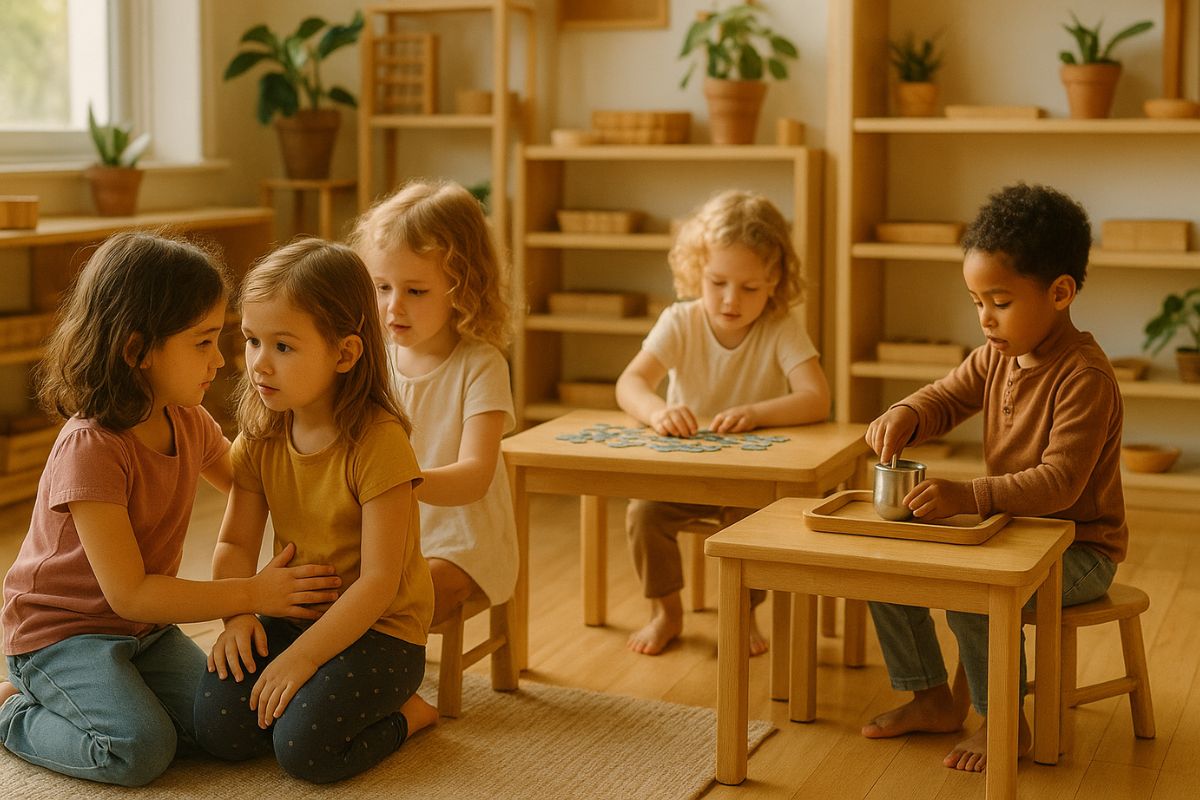A child’s development reaches far beyond academics. The way they form friendships, solve conflicts, express feelings, and care for others shapes their daily lives and long-term well-being. In Montessori classrooms, social and emotional growth isn’t a separate subject. It’s woven into every part of the environment, from the way materials are handled to how conversations unfold.
Children don’t just learn with their minds—they learn with their hearts and through relationships. Montessori educators understand that emotional intelligence and strong social skills give children the confidence to work independently, collaborate with others, and navigate the world with empathy.
Building the Foundation for Connection and Compassion
This article explores:
- How Montessori environments naturally support emotional development
- The role of community, grace and courtesy, and peer learning
- Strategies guides use to nurture kindness, resilience, and responsibility
- Why social and emotional learning is essential for lifelong growth
From toddlerhood to adolescence, children in Montessori classrooms grow in self-awareness and compassion through meaningful daily interactions.
Emotional Awareness Begins with Respect
The Montessori approach begins with a deep respect for the child. From the earliest ages, children are spoken to gently, listened to carefully, and given space to express how they feel. Rather than being told to stop crying or to calm down without support, children are invited to understand and name their emotions.
In toddler and primary environments, this might mean a child saying, “I’m sad,” after a toy is taken, or “I want a turn,” when waiting for a material. Instead of rushing to fix the situation, the guide creates space for the child to work through the moment and be heard.
This simple but powerful habit builds emotional awareness. Children begin to recognize feelings not just in themselves but in others. They start to develop empathy by watching how their words and actions affect their classmates.
Grace and Courtesy as Daily Practice
Montessori classrooms include lessons in grace and courtesy. These are not lectures on manners—they’re gentle demonstrations of how to live peacefully in a community. Children practice saying “please,” “thank you,” and “excuse me,” but also learn how to offer help, resolve misunderstandings, and respect one another’s space.
A child might learn how to wait for a material without interrupting. Or how to carry a tray carefully so others feel safe nearby. These lessons become part of the classroom culture and are reinforced not by rules, but by consistent modeling and repetition.
Over time, these habits create a sense of harmony. The classroom becomes a respectful and calm space where children feel seen and valued.
Peer Relationships and Mixed-Age Classrooms
Montessori classrooms are intentionally designed with mixed-age groups. A three-year-old may work beside a five-year-old. A ten-year-old may mentor an eight-year-old. These relationships allow children to learn from one another in natural, non-competitive ways.
Older students gain confidence by helping others. Younger students feel inspired by those just ahead of them. When conflicts arise—as they always do—the guide supports the children in resolving them respectfully. Rather than punishing or separating, the goal is to restore connection and help the children find peaceful solutions.
This peer-to-peer dynamic fosters cooperation over competition. It shows children that their voice matters, and that they are capable of supporting others as well as being supported.
Conflict Resolution and Communication
Montessori guides do not avoid conflict. Instead, they use it as an opportunity for growth. If two children disagree, the guide may invite them to sit together and take turns speaking. Sometimes a peace table or special object is used to help signal whose turn it is to talk.
Children are taught to listen fully, to speak from their own experience, and to look for solutions together. This approach builds strong communication skills. It teaches that conflicts can be worked through, not avoided or ignored.
Even the youngest children begin to say things like, “I didn’t like that,” or “Can we try again?” These phrases give them ownership of their emotions and help them take part in restoring peace.
Independence Builds Confidence and Resilience
Part of emotional growth is learning how to trust yourself. Montessori environments give children opportunities to make choices, complete tasks, and manage small challenges on their own.
When a child spills water, they don’t wait for someone else to clean it up. They get a towel, dry the floor, and move on. These small moments teach that mistakes aren’t failures—they’re part of learning.
Over time, this builds resilience. A child learns to try again, to adapt, and to feel proud of their effort. They also learn how to ask for help when needed, without feeling ashamed.
Independence in Montessori doesn’t mean isolation. It means being capable within a supportive community. This balance strengthens emotional maturity and inner peace.
Adolescents and the Need for Meaningful Connection
As children grow into adolescence, social and emotional needs deepen. Montessori programs for older students include group projects, real-world work, and time for reflection. These experiences help students understand their identity and role in a larger world.
Adolescents often take part in running a classroom business, working in gardens, or planning community service. These activities build responsibility and show them that their contributions matter. Reflection through journaling, group dialogue, or quiet time allows space for self-awareness.
At this age, guides serve as mentors, helping students think through challenges and consider others’ perspectives. The classroom remains a safe space for vulnerability, creativity, and honest conversation.
A Community that Nurtures the Whole Child
Montessori classrooms are more than places to learn math or reading. They are living communities where children grow in compassion, responsibility, and emotional strength. Social and emotional learning is not a separate subject—it is part of every moment, every choice, and every relationship.
Children who grow up in this kind of environment carry those lessons with them. They learn how to speak kindly, to listen deeply, to lead with humility, and to care for others. These skills serve them well not just in school, but in life.
